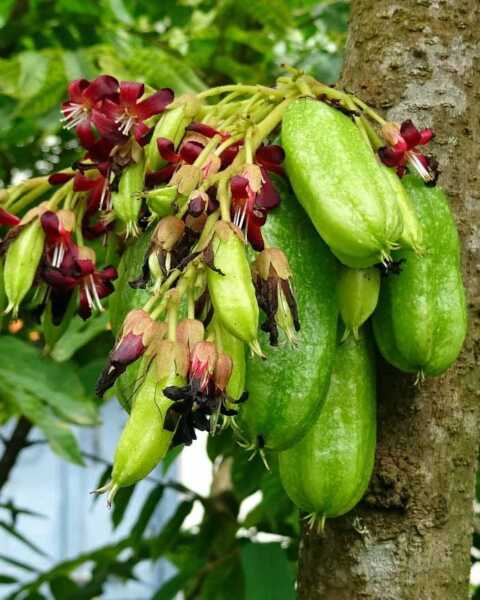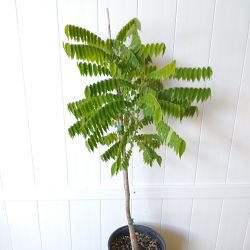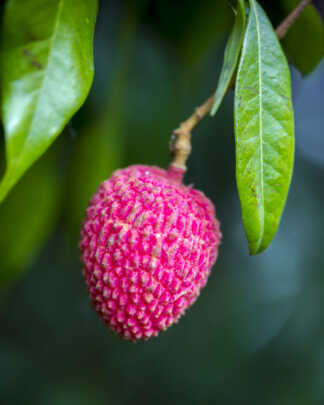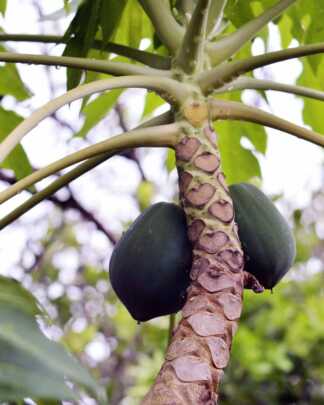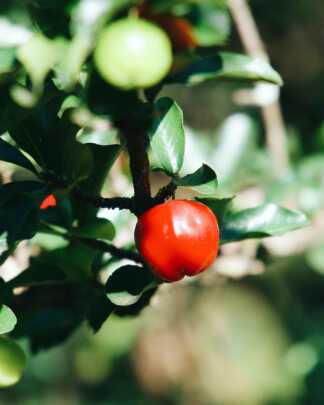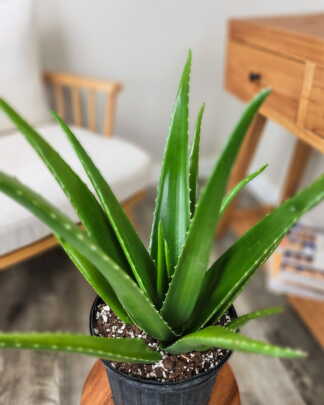Description
Caring for your Bilimbi Fruit Tree
The Bilimbi Fruit Tree (Averrhoa bilimbi), often referred to simply as “Bilimbi” or “Cucumber Tree,” is a tropical fruit tree native to Southeast Asia. Known for its unique, tangy, cucumber-shaped fruits, the Bilimbi is widely cultivated in warm climates for its culinary uses and ornamental appeal. The sour fruits are often used in pickles, chutneys, sauces, and beverages, making this tree a valuable addition to any tropical garden. With its attractive foliage, delicate flowers, and bountiful fruit production, the Bilimbi tree is both practical and beautiful.
Light
The Bilimbi tree thrives in full sun, requiring at least 6-8 hours of direct sunlight daily for optimal growth and fruit production. For best results, plant the Bilimbi tree in a location where it will receive abundant sunlight throughout the day. If you’re growing the tree indoors or in a partially shaded spot, it may still survive, but the growth and fruit production will be significantly reduced.
When grown in cooler climates or indoors, make sure to place the tree near a bright, south-facing window, or supplement the light with grow lights to ensure it gets enough sunlight to thrive.
Water
Bilimbi trees prefer consistently moist soil but are also sensitive to waterlogged conditions. It is essential to keep the soil evenly moist without allowing it to become soggy. Water your Bilimbi tree deeply and regularly, especially during dry periods or the hot growing season. The goal is to keep the soil around the root zone moist but well-drained.
For young trees, water them 2-3 times per week to help establish strong roots. As the tree matures, you can reduce watering to once or twice per week, depending on rainfall and temperature. However, avoid letting the soil completely dry out, as this can stress the tree and reduce fruit production.
During the dormant period (winter in some climates), reduce watering, but make sure to maintain some moisture in the soil. If you’re growing the tree indoors or in a container, water when the top inch of soil feels dry to the touch.
Soil
Bilimbi trees prefer rich, well-draining soil with a slightly acidic to neutral pH, typically in the range of 5.5 to 7.5. Sandy loam or loamy soils enriched with organic matter are ideal for these trees, as they provide the right balance of moisture retention and drainage. While Bilimbi trees can tolerate a range of soil types, they will perform best in nutrient-rich, well-aerated soil.
If you’re planting the tree in the ground, work organic compost or well-rotted manure into the soil to improve its nutrient content. For container-grown trees, use a high-quality potting mix with good drainage properties and add organic compost to ensure the tree receives ample nutrients.
Temperature
The Bilimbi tree is a true tropical plant and thrives in warm, humid climates. It grows best in USDA hardiness zones 10-12, where temperatures remain above 55°F (13°C) year-round. The tree cannot tolerate frost or prolonged exposure to cold temperatures, so if you live in a cooler region, you’ll need to grow your Bilimbi tree in a container that can be brought indoors during the colder months.
Ideal temperatures for Bilimbi range from 75°F to 95°F (24°C to 35°C), and the tree performs best in areas with high humidity. If growing indoors or in a dry climate, you can increase humidity by placing the tree near a humidifier or misting it regularly to keep the air around it moist.
Fertilization
Bilimbi trees are relatively heavy feeders and benefit from regular fertilization to support healthy growth and fruit production. During the growing season (spring through summer), apply a balanced, slow-release fertilizer with an NPK ratio of around 10-10-10 or 14-14-14 every 6-8 weeks. This will provide the tree with essential nutrients such as nitrogen for leaf development, phosphorus for root growth, and potassium for fruiting.
Additionally, supplement the tree with organic compost or well-rotted manure in the spring and mid-summer to improve soil health and nutrient content. Be cautious not to over-fertilize, as this can lead to excessive leaf growth at the expense of fruit production.
In the winter, reduce the frequency of fertilization, as the tree’s growth will naturally slow down during this period.
Pruning and Maintenance
Bilimbi trees generally require minimal pruning, but regular maintenance will help the tree stay healthy and productive. Prune the tree in late winter or early spring before the new growth starts. Focus on removing dead, damaged, or diseased branches, as well as any branches that are crossing or growing inward, which can reduce air circulation and lead to fungal infections.
If your Bilimbi tree becomes too dense, thin it out by removing excess branches to allow more sunlight to penetrate through the canopy. This will improve fruit production and help prevent pests and diseases.
When pruning, always use clean, sharp tools to make clean cuts and reduce the risk of infection.
Pest and Disease Control
Bilimbi trees are relatively resistant to pests and diseases, but they can occasionally suffer from common fruit tree problems such as aphids, scale, or mites. Regularly inspect your tree for signs of infestation, including yellowing leaves, sticky residue, or discolored spots. Treat infestations with insecticidal soap, neem oil, or horticultural oil.
In terms of disease, Bilimbi trees are prone to fungal infections like anthracnose, especially in humid environments. To prevent fungal issues, ensure good air circulation around the tree by pruning regularly and avoid overwatering. If you notice fungal spots on the leaves or fruit, apply a fungicide to control the spread of the infection.
Harvesting
Bilimbi fruits grow in clusters on the trunk or large branches of the tree, typically ripening several times a year in tropical climates. The fruits are usually ready to harvest when they are full-sized and have turned light green or yellow, depending on the variety. The fruits are extremely sour when unripe but become slightly less acidic as they ripen.
To harvest the fruit, simply cut the clusters from the tree. Bilimbi fruits are best used fresh for cooking or making beverages, as they have a short shelf life and can spoil quickly once harvested.

